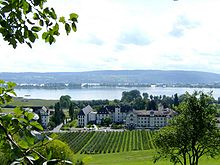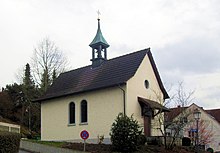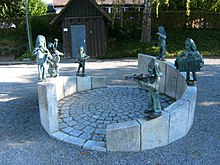Allensbach
| coat of arms | Germany map | |
|---|---|---|

|
Coordinates: 47 ° 43 ' N , 9 ° 4' E |
|
| Basic data | ||
| State : | Baden-Württemberg | |
| Administrative region : | Freiburg | |
| County : | Constancy | |
| Height : | 400 m above sea level NHN | |
| Area : | 26.54 km 2 | |
| Residents: | 7087 (December 31, 2018) | |
| Population density : | 267 inhabitants per km 2 | |
| Postal code : | 78476 | |
| Area code : | 07533 | |
| License plate : | KN | |
| Community key : | 08 3 35 002 | |
| LOCODE : | DE A7A | |
| Community structure: | 4 districts | |
| Address of the municipal administration: |
Rathausplatz 1 78476 Allensbach |
|
| Website : | ||
| Mayor : | Stefan Friedrich ( CDU ) | |
| Location of the community of Allensbach in the district of Constance | ||
Allensbach ( ) is a municipality on Lake Constance in the district of Konstanz in Baden-Württemberg in Germany .
The place is known nationwide as the seat of the Allensbach Institute for Demoscopy .
geography
location
Allensbach is located between Constance and Radolfzell . The core town lies directly on the shores of the part of Lake Constance called Gnadensee opposite the island of Reichenau . The entire community extends from Gnadensee over the Bodanrück to Überlinger See at an altitude of 397 to 520 m above sea level. NHN .
Community structure
The municipality of Allensbach with the formerly independent municipalities of Hegne, Kaltbrunn and Langenrain includes 16 villages, hamlets, farms and houses. The integrated former municipalities form the localities in the sense of the Baden-Württemberg municipal code of Hegne , Kaltbrunn and Langenrain-Freudental .
Only the village of Allensbach belongs to the municipality of Allensbach in the 1973 boundaries. The former municipality of Hegne includes the village of Hegne, Hegne Castle and the houses Adelheiden, Hegne train station and weekend house on the lake. The former community of Kaltbrunn includes the village of Kaltbrunn, the farms Gemeinmerk, Türrainhöfe and Waldburgahöfe and the house Fischerhaus. The villages of Langenrain and Freudental and the Höfe, Kargegg and Stöckenhof farms belong to the former municipality of Langenrain.
In the municipality of Allensbach in the territorial status of 1973 are the desert areas of Azenhausen, Buchenhausen, Eigenhofen, Kappel, Pfahlstetten and Weildorf. The abandoned farm Hinter Honberg is located in the area of the former municipality of Kaltbrunn. The Storkenhof in the area of the former municipality of Langenrain has risen in Langenrain.
history
The Allensbach district was already a settlement area in prehistoric and early historical times, there are both prehistoric pile dwellings and traces of Roman times . During the construction of the Rottweil – Konstanz natural gas pipeline east of the Mindelsee , near west of the Stöckenhof (district of Langenrain), parts of the foundation wall of a villa rustica were cut and exposed in 1979. The site of the pile dwelling settlement in the lido has been part of the UNESCO World Heritage Site of Prehistoric Pile Dwellings around the Alps since 2011 .
Allensbach emerged as an Alemannic village in the 4th century at the latest . It was named after an Alemannic tribal leader named Alahol , who lived with his clan on - presumably - today's Mühlenbach.
The village is mentioned for the first time as Alaspach in 724 in the founding document of the Reichenau monastery , to whose initial equipment it was part. As a landing stage for the Reichenaufehre and as a market town , it held a special position. The Allensbacher Markt, along with the Konstanzer and the Rorschacher, is one of the oldest demonstrable in the Lake Constance area. In the Middle Ages it had city rights and a city wall.
In the 16th century , Allensbach came into the possession of the Prince Diocese of Constance , which belonged to the Swabian Empire . During the Thirty Years War Allensbach was repeatedly occupied, looted and set on fire. The town charter, which was once occupied, was lost in the chaos of war. The town charter has been suspended to this day - it has neither been revoked nor recognized again. In 1803 Allensbach experienced the last change of ownership and came to the Grand Duchy of Baden .
Today's community Allensbach was created on January 1, 1975 through the merger of the communities Allensbach and Hegne. On July 1, 1974, the communities of Kaltbrunn and Langenrain were incorporated into Allensbach. The former municipality of Freudental was merged with Langenrain as early as 1938.
- Coats of arms of the former municipalities
Religions
Due to the affiliation to the Hochstift Konstanz , the Reformation passed Allensbach by. Even today, the majority of the residents are Catholic, and there are Roman Catholic churches in the center of town and in Hegne . Since 1955 there has also been a Protestant church in town.
In Hegne is the Hegne Monastery of the Sisters of Mercy of the Holy Cross and the seat of the Baden-Württemberg Order of this Congregation. The sisters run the St. Elisabeth conference and guest house , the Marianum school and the Maria Hilf nursing home .
politics
Administrative community
Allensbach connects an agreed administrative community with Reichenau and Konstanz .
Municipal council
In the local elections on May 26, 2019 , the following distribution of seats resulted. The turnout was 68.19% (2014: 57.7%). The municipal council consists of the elected voluntary councilors and the mayor as chairman. The mayor is entitled to vote in the municipal council.
| Party / list | % | Seats | 2014 result |
|---|---|---|---|
| CDU | 40.75% | 8 seats | 43.9%, 9 seats |
| Free voters Allensbach | 25.66% | 5 seats | 25.5%, 5 seats |
| SPD | 14.14% | 3 seats | 17.1%, 3 seats |
| Colorful list Allensbach | 16.14% | 3 seats | 13.6%, 3 seats |
| FDP | 3.32% | 1 seat | 0.0%, 0 seats |
mayor
Mayor of Allensbach is Stefan Friedrich. He has held the office since July 8, 2015, after being elected on April 19, 2015 with 79 percent of the vote. His predecessor was Helmut Kennerknecht, who had been mayor since July 4, 1983.
- until 1933: Albert Keller
- 1933–1945: Josef Mayer
- 1945–1948: Gottfried Mayer
...
- 1963–1983: Hermann Brunner
- 1983–2015: Helmut Kennerknecht ( CDU )
- since 2015: Stefan Friedrich (CDU)
coat of arms
Blazon : from red and blue quartered by a golden (yellow) cross attached with a golden (yellow) ring, in field 1 and 2 a silver (white) fish swimming diagonally towards the center of the shield, on the lower cross bar a pole-like silver (white) fish, with the heads touching the outer edge of the ring.
The cross in the Allensbach coat of arms indicates that it was part of the Reichenau monastery, the ring comes from the coat of arms of Abbot Markus von Knöringen . The fish that swim towards the ring are intended to indicate the important catch.
- Heraldic saga
The Allensbach coat of arms legend reports that Karl Martell had a circlet placed in the brook in order to find a name for Allensbach. The place should be named after the first fish to swim through. This was an Alet from the carp family and the place was henceforth called Aletbach .
Culture and sights
Museums
The local history museum on Rathausplatz is a project run by the local history association Arbeitsgemeinschaft Allensbach e. V. publicly made collection that shows an overview from the Neolithic Age (finds in today's lido) to the 20th century.
Buildings
- The baroque Catholic Nikolauskirche with its onion dome built in 1698 and the nave built from 1732 to 1735 is the landmark of Allensbach. Inside the church there is a high altar made in 1804 and two rococo side altars from around 1750.
- The Freudental Castle in the village Freudental is a 1698-built Baroque castle with a gabled facade, which is used as a seminar and conference venue and as accommodation for holidaymakers.
- The Bodman baroque castle Schloss Langenrain , built in 1686, is now privately owned by the Graf von Oppersdorff family .
- The Protestant Gnadenkirche (built in 1955, expanded in 1997) and the lido (2004) are modern architecture.
- The Hegne Castle is located on the B33 in Allensbach Hegne district. First mentioned in writing in 1570, it was the summer residence of the Bishops of Constance between 1591 and 1803 . From 1879 to 1882 by Werner de Weerth from Neuwied , it was significantly rebuilt in the neo-renaissance style. Today it is part of a building complex which, in addition to the monastery of the Sisters of Mercy of the Holy Cross, also houses various educational and charitable institutions (see also sections "Religions" and " Educational institutions ").
Sculptures
There is a group of figures in a rotunda on the lakeshore near the ship landing stage.
Natural monuments
In the municipality of is located on the south shore Lake Überlinger the Marienschlucht .
Regular events
Every year from July to October the concerts of the “JAZZ am See” series take place in the Seegarten or in the Protestant church in Allensbach, and once a year the Seetorfest takes place for a weekend.
Economy and Infrastructure
traffic
Allensbach is located on the Hochrheinbahn , on which regional express trains run every half hour in addition to the Seehas local transport line. Another train stop is outside Hegne, where the Seehas trains stop. Allensbach is part of the Hegau-Bodensee transport association.
In the summer half-year there is a passenger boat connection to the island of Reichenau .
Allensbach is connected to the federal highway 33 .
Established businesses
Educational institutions
There is a primary school in Allensbach itself and in the Hegne district . There are also three communal kindergartens and a Roman Catholic kindergarten.
In the Marianum of the Sisters of Mercy of the Holy Cross in Hegne, seven private educational institutions are combined: a secondary school, a social science high school (SG), a two-year vocational school for home economics and nutrition (2BFS), a vocational college for interns (1BKSP), a technical school for social education ( 2BKSP), a technical school for organization and leadership (FOF) and a vocational school for acquiring additional qualifications (BFQ-E).
The Allensbach University , named after Allensbach , is based in Constance.
Leisure and sports facilities
The Allensbach Wildlife and Leisure Park is a tourist attraction in Allensbach .
Personalities
Honorary citizen
- Elisabeth Noelle-Neumann (1916–2010), founder of the Allensbach Institute for Demoscopy (IfD)
- Julius Boltze, publisher, local researcher and co-founder of the local history association Arbeitsgemeinschaft Allensbach e. V. (AGA)
sons and daughters of the town
- Rolf Andra (* 1907 in Hegne as Josef Fuchs; † 1998 ibid), magician and specialist author
- Niklaus Schradin (* in Allensbach; † between February 1506 and 1518 in Lucerne ), chronicler and scribe in the service of the St. Gallen Abbey and the city of Lucerne
Other personalities
- Hermann Dietrich (1879–1954), politician of the German Democratic Party as well as Minister and Vice Chancellor in the Weimar Republic (lived in Allensbach after 1945)
- Otto Marquard (1881–1969), painter, artist and resistance fighter, lived in Allensbach
- Fritz Mühlenweg (1898–1961), painter and writer, lived in Allensbach
- Elisabeth Mühlenweg (1910–1961), painter and illustrator, lived and died in Allensbach
- Walter Tilgner (* 1934), biologist, nature photographer and sound engineer, lives with his wife Heidrun in Allensbach
- Gaby Hauptmann (* 1957), writer, lives in Allensbach
particularities
The Stone Age dagger from Allensbach
In the winter of 2002/2003, the construction site of a new building on the Allensbach campsite was examined by archaeologists from the office for underwater and wet soil archeology in Hemmenhofen . About 1.5 m below the current surface, the remains of a pile dwelling settlement that had been founded at this point were found.
The find material recovered there held several surprises in store, above all a long, perfectly crafted flint dagger with a completely preserved wooden handle made of elder wood. To date , a similar dagger with a preserved shaft has only been found in the equipment of the " Ötzi ", the famous glacier mummy from Tisenjoch . Like the dagger from “Ötzi”, the Allensbacher dagger blade is not made from local raw material, but from high-quality Upper Italian flint . The flint blade, together with other imported finds, shows that the pile dwelling residents from Lake Constance had regular contact with the southern Alpine region in northern Italy around 5000 years ago.
literature
- Julius Boltze: Old and always young Allensbach on Lake Constance. Landscape, history, folklore . 2., through u. exp. Ed. Verlag des Südkurier, Konstanz 1983, ISBN 978-3-87799-007-0 .
- Benedikt Schwarz: Allensbacher interest and statutes (village law) in the 16th century. In: Writings of the Association for the History of Lake Constance and its Surroundings , 52nd year 1923, pp. 57–83 ( digitized version )
- W. Wartmann: To the coat of arms of Allensbach. In: Writings of the Association for the History of Lake Constance and its Surroundings , 37th year 1908, pp. 172–175 ( digitized version )
Web links
- Allensbach community
- Local history association Arbeitsgemeinschaft Allensbach eV
- Allensbach at LEO-BW
Individual evidence
- ↑ State Statistical Office Baden-Württemberg - Population by nationality and gender on December 31, 2018 (CSV file) ( help on this ).
- ^ The state of Baden-Württemberg. Official description by district and municipality. Volume VI: Freiburg region Kohlhammer, Stuttgart 1982, ISBN 3-17-007174-2 . Pp. 755-758
- ↑ Cf. Rolf Dehn, Gerhard Fingerlin : Excavations of the archaeological monument preservation Freiburg in 1979. Archaeological news from Baden, issue 24. Freiburg im Breisgau 1980.
- ↑ See Jörg Aufdermauer: Traces of prehistoric and early historical settlement in the Mindelsee area . In: State Institute for Environmental Protection Baden-Württemberg Institute for Ecology and Nature Conservation (Ed.): The Mindelsee near Radolfzell - monograph of a nature reserve on the Bodanrück . Karlsruhe 1983. pp. 17-28; here p. 26f.
- ^ Find reports from Baden-Württemberg. Volume 10: 1985. Ed. Baden-Württemberg State Monuments Office, 1986, p. 523.
- ↑ Eric Breuer: Heimatkundliche Schriften des Kulturverein Eriskirch e. V. Volume 3: Romans on northern Lake Constance: Eriskirch and the surrounding area in Roman times. Edited by Kulturfreunde Eriskirch, 2001, p. 36.
- ↑ Jürgen Hald: From the Stone Age to the Alemanni - archaeological finds in Radolfzell and the districts . In: City of Radolfzell am Bodensee, Department of City History (Hildegard Bibby, Katharina Maier) (Ed.): Radolfzell am Bodensee - The Chronicle . Stadler, Konstanz 2017, ISBN 978-3-7977-0723-9 . Pp. 12-26.
- ↑ Source: Vorarlberger Landesmuseum Bregenz, in: Listed! Finds of pile dwellings on the Untersee In: Südkurier from September 9, 2011
- ^ Allensbacher history (s) on www.allensbach.de
- ↑ Max Miller , Gerhard Taddey (ed.): Handbook of the historical sites of Germany . Volume 6: Baden-Württemberg (= Kröner's pocket edition . Volume 276). 2nd, improved and enlarged edition. Kröner, Stuttgart 1980, ISBN 3-520-27602-X , p. 12.
- ^ Federal Statistical Office (ed.): Historical municipality directory for the Federal Republic of Germany. Name, border and key number changes in municipalities, counties and administrative districts from May 27, 1970 to December 31, 1982 . W. Kohlhammer, Stuttgart / Mainz 1983, ISBN 3-17-003263-1 , p. 519 .
- ↑ Jörg-Peter Rau: Live ticker for the mayor election: Stefan Friedrich makes the race. In: suedkurier.de. Südkurier , April 19, 2015, accessed April 19, 2015 .
- ↑ Thomas Zoch: Mayor Friedrich: Start of a new era. In: suedkurier.de. Südkurier , July 9, 2015, accessed on July 17, 2015 .
- ↑ Matthias Biehler: Mayor: There can only be one list . In: Südkurier of July 17, 2018
- ^ The annals of the NSDAP in Allensbach: When a "rough SA man" sat in the town hall with Josef Mayer . In: Südkurier of May 10, 2010
- ↑ Description of coat of arms on Discover regional studies online
- ↑ Description of the coat of arms on www.allensbach.de
- ↑ The Allensbach coat of arms legend on www.allensbach.de
- ^ Portrait of Marquard on the website of the municipality of Allensbach, accessed on June 13, 2011.

















